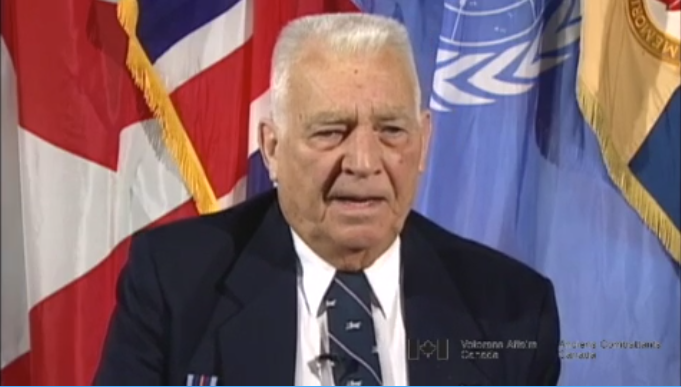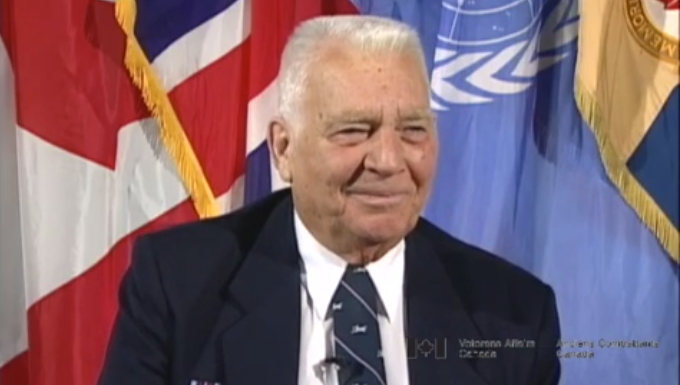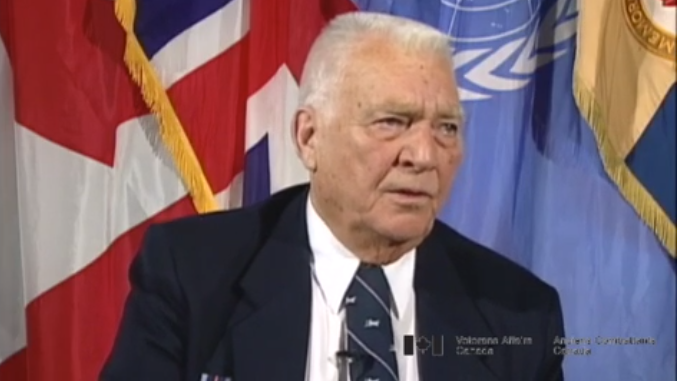Our ground crew was just terrific, our planes were usually in
perfect shape but this one night we got into one bomber and
the pilot said it’s US unserviceable.
So we got out of it and got into another one, the same thing.
We got into the third one and took off and got over the air
field and as I say you like to be close to the others, well
they were gone by the time we got up there.
And a motor quit, while we were over our own station.
So the air force were kind of superstitious, three times and
out so the pilot says, “We really have reason to not go but
I’m going to take a vote.” He always started with the tail
gunner so I said, “Oh lets’s go, three motors is lots in this
plane.” The mid upper gunner was 32 years old with a wife
and daughter in St. Catharines. He said, “No, we shouldn’t
go this is the third plane. The others are gone.”
But they took a vote, four against three, we went with three
motors. Our navigator had lost a brother already in the air
force and he said to the skipper, he said, “We can cut the
dog’s legs off,” dog’s legs like they sent you in different
directions, try and fool the enemy.
So he said, “we’ll cut the dog’s legs off,
we won’t be too far behind the rest of the bombers.”
So we get to the target, and of course as soon as you dropped
your bombs you dove down in certain directions so the
planes look to be going home at a terrific speed and we’re
going over the target. And of course by that time there was
a tremendous shooting up at us, aircraft, shooting up and the
explosions and the planes were bouncing around.
So going over the target it was so rough that the bomb
aimer says, “I’m sorry skipper we have to go around again.”
So that was always annoying. Every minute you spent over
the target you knew you were going to be shot at.
Anyway we went around the second time and he said,
“Bombs gone,” so the skipper says, “We’ll get out of here!”
So we started for home just barely left the target when we
got coned in search lights. Once one search light gets on
you then others can just come on you like that and it’s
brighter than daylight. So the skipper said, “Gunners, keep
one eye closed so you can see when we get out of this.”
He says, “We’re going to try and get out!”
So he dove down evasive action and we did get out,
we went down from 23,000 feet to six or seven.
I had a pain across my head, I thought it was just like an axe
splitting all of a sudden it snapped and it didn’t hurt.
We got headed for the channel and a second motor quit so
we had two motors left so he said, “be prepared to throw
everything out we don’t need. We might have to ditch in
the channel”. We got across the channel, the plane started
to ice up, a certain height it would ice up depending on the
weather. So he said to still be prepared, we might have to
bail out. So I called up. I said, “Skipper, the bomb aimer
and I’ll bail out. It’ll lighten the load, we’ll hitch hike back
to camp.” He said, “Shut up, if anybody bails out we all
bail out!” So we got back and landed on two motors,
just got landed and then the third motor quit.
We taxied back to our parking space with one motor.
So I would say that was probably the scariest trip I had.






